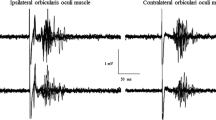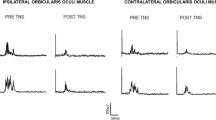Abstract
Objective
In this study, we analyzed the inhibitory control on the trigemino-cervical reflex (TCR), and whether or not prepulse modulation (PPM) has an effect on TCR. Thus, we studied the PPM of TCR. We hypothesized that TCR would presumably be under the modulatory effect after the prepulse stimulus similar to blink reflex (BR). We also studied the recovery of TCR which was previously shown.
Methods
We included 13 healthy individuals. All subjects underwent recordings of TCR, TCR-PPM, and recovery of TCR. For TCR-PPM, a subthreshold stimulus to second finger 50 or 100 ms before the test stimulus was applied. For recovery of TCR, two stimuli at the infraorbital nerve were applied at 300, 500, and 800 ms interstimulus intervals (ISIs).
Results
There was an inhibition of bilateral late responses of TCR at the ISIs of both 50 ms and 100 ms. There was no change of latencies. Full recovery of TCR did not develop even at the ISI 800 ms.
Discussion
We have provided an evidence for the TCR-PPM in healthy subjects for the first time in this study. The prepulse inhibition is attributed to the functions of the pedunculopontine tegmental nucleus. Our study provides a strong indication that there are connections between pedunculopontine tegmental nucleus and trigemino-cervical circuit, which produces TCR.


Similar content being viewed by others
References
Valls-Sole J, Valldeoriola F, Molinuevo JL, Cossu G, Nobbe F (1999) Prepulse modulation of the startle reaction and the blink reflex in normal human subjects. Exp Brain Res 129:49–56
Gómez-Wong E, Valls-Solé J (1996) Effects of a prepulse stimulus on the masseteric inhibitory reflex in humans. Neurosci Lett Apr 208:183–186
Alvarez-Blanco S, Leon L, Valls-Solé J (2009) The startle reaction to somatosensory inputs: different response pattern to stimuli of upper and lower limbs. Exp Brain Res 195:285–292
Brown P, Rothwell JC, Thompson PD, Britton TC, Day BL, Marsden CD (1991) New observations on the normal auditory startle reflex in man. Brain 114:1891–1902
Di Lazzaro V, Restuccia D, Nardone R, Tartaglione T, Quartarone A, Tonali P, Rothwell JC (1996) Preliminary clinical observations on a new trigeminal reflex: the trigemino-cervical reflex. Neurology 46:479–485
Ertekin C, Celebisoy N, Uludağ B (2001) Trigeminocervical reflexes elicited by stimulation of the infraorbital nerve: head retraction reflex. J Clin Neurophysiol 18:378–385
Sartucci F, Rossi A, Rossi B (1986) Trigemino cervical reflex in man. Electromyogr Clin Neurophysiol 26:123–129
Leandri M, Gottlieb A, Cruccu G (2001) Head extensor reflex evoked by trigeminal stimulation in humans. Clin Neurophysiol 112:1828–1832
Nakashima K, Thompson PD, Rothwell JC, Day BL, Stell R, Marsden CD (1989) An exteroceptive reflex in the sternocleidomastoid muscle produced by electrical stimulation of the supraorbital nerve in normal subjects and patients with spasmodic torticollis. Neurology 39:1354–1358
Di Lazzaro V, Quartarone A, Higuchi K, Rothwell JC (1995) Short-latency trigemino-cervical reflexes in man. Exp Brain Res 102:474–482
Serrao M, Cortese F, Andersen OK, Conte C, Spaich EG, Fragiotta G, Ranavolo A, Coppola G, Perrotta A, Pierelli F (2015) Modular organization of the head retraction responses elicited by electrical painful stimulation of the facial skin in humans. Clin Neurophysiol 126:2306–2313
Serrao M, Rossi P, Parisi L, Perrotta A, Bartolo M, Cardinali P, Amabile G, Pierelli F (2003) Trigemino-cervical-spinal reflexes in humans. Clin Neurophysiol 114:1697–1703
Kızıltan ME, Gunduz A, Kızıltan G, Tekeoğlu A, Sohtaoğlu M (2014) Brainstem and spinal reflex studies in patients with primary progressive freezing of gait. J Neurol Sci 343:51–55
Serrao M, Coppola G, Di Lorenzo C, Di Fabio R, Padua L, Sandrini G, Pierelli F (2010) Nociceptive trigeminocervical reflexes in healthy subjects. Clin Neurophysiol 121:1563–1568
Serrao M, Perrotta A, Bartolo M, Fiermonte G, Pauri F, Rossi P, Parisi L, Pierelli F (2005) Enhanced trigemino-cervical-spinal reflex recovery cycle in pain-free migraineurs. Headache 45:1061–1068
Graham FK Presidential Address, 1974(1975) The more or less startling effects of weak prestimulation. Psycophysiology 12:238–248
Prentice SD, Drew T (2001) Contributions of the reticulospinal system to the postural adjustments occurring during voluntary gait modifications. J Neurophysiol 85:679–698
Drew T, Prentice S, Schepens B (2004) Cortical and brainstem control of locomotion. Prog Brain Res 143:251–261
Leon-Sarmiento FE, Peckham E, Leon-Ariza DS, Bara-Jimenez W, Hallett M (2015) Auditory and lower limb tactile prepulse inhibition in primary restless legs syndrome: clues to its pathophysiology. J Clin Neurophysiol 32:369–374
Serrao M, Di Fabio R, Bartolo M, Perrotta A, Tassorelli C, Coppola G, Davassi C, Padua L, Sandrini G, Pierelli F (2011) The contribution of trigemino-cervical reflexes in distinguishing progressive supranuclear palsy from multiple system atrophy. Clin Neurophysiol 122:1812–1815
Meredith MA, Wallace MT, Stein BE (1992) Visual, auditory and somatosensory convergence in output neurons of the cat superior colliculus: multisensory properties of the tecto-reticulo-spinal projection. Exp Brain Res 88:181–186
Sasaki S, Yoshimura K, Naito K (2004) The neural control of orienting: role of multiple-branching reticulospinal neurons. Prog Brain Res 143:383–389
Ge HY, Collet T, Mørch CD, Arendt-Nielsen L, Andersen OK (2007) Depression of the human nociceptive withdrawal reflex by segmental and heterosegmental intramuscular electrical stimulation. Clin Neurophysiol 118(7):1626–1632
Acknowledgements
The authors thank Zeynep Değirmenci, Sibel Kilinc, Vildan Altop, Mecit Sepetcioglu, and Esat Cetinkaya for excellent technical assistance.
Author information
Authors and Affiliations
Corresponding author
Ethics declarations
The study was approved by the institutional review board, and informed consent was obtained.
Conflict of interest
The authors declare that they have no conflict of interest.
Rights and permissions
About this article
Cite this article
E. Kızıltan, M., Bekdik Şirinocak, P., Akıncı, T. et al. Prepulse modulation and recovery of trigemino-cervical reflex in normal subjects. Neurol Sci 40, 305–310 (2019). https://doi.org/10.1007/s10072-018-3624-7
Received:
Accepted:
Published:
Issue Date:
DOI: https://doi.org/10.1007/s10072-018-3624-7




